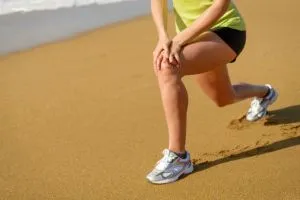You probably don’t think much about your shoulders, knees, back and other joints until they stop functioning properly or cause pain. Your joints are an important part of daily living, and if you suffer from joint pain, it makes it difficult to perform many tasks we often take for granted.
This type of pain is one of the top reasons older adults visit their healthcare provider. By taking care of your joints and keeping them limber, you’ll not only decrease the chances of experiencing painful movement, you could prevent yourself from becoming one of the one million new cases of arthritis every year.
Build muscle mass
One of the best ways to battle joint pain is through exercise, including increasing muscle strength and flexibility. As the muscles act as cushions and shock absorbers for the joints, you need muscle to protect them from damage. Strength training helps to maintain and increase muscle mass as well as to reduce fat buildup.
Losing those stubborn pounds will take some of the strain off your hips and knees, while extra pounds add to the pressure that’s placed upon them, increasing the risk of cartilage breakdown.
Get moving
Regular physical activity is essential for healthy, limber joints. If you have a sedentary job, be sure to get up and move at least every hour. If you’re already struggling with joint problems, participate in low impact activities like walking, biking, swimming and rowing as high impact exercise like running can increase your risk of joint injuries and cause cartilage damage. Be sure to combine your cardio activities with strength training as mentioned above.
Watch what you eat
Your diet is important for preventing all types of illness and disease as well as keeping your joints limber and healthy. Stay hydrated by drinking at least eight 8-ounce glasses of water each day, consume lots of antioxidant-rich foods like dark leafy greens and brightly colored organic produce as well as foods that contain lots of omega-3 fatty acids like wild-caught salmon and almonds. Limit or eliminate processed foods and refined sugars which contribute to inflammation and joint problems as well as to many other health conditions.
Stretch regularly
Stretch regularly by moving joints through their full range of motion, which reduces stiffness and helps to keep them flexible. Be sure and warm up by marching in place or walking first as stretching cold joints can be harmful.
Most fitness experts recommend holding each stretch for 30 seconds, keeping joints and muscles still and stretching just to the point where a slight tightness is felt – never to the point of pain.

Good posture helps your muscles and skeletal system work together, which places less strain on your joints. It also prevents the bones from rubbing against each other unnecessarily at the joints and can even help prevent or stave off arthritis. When you feel yourself starting to slouch, try to remember to stand or sit up straight. Once you’ve developed this habit, it will ease stress on your muscles, too.
-The Alternative Daily
Sources:
http://www.fiftyplusadvocate.com/archives/9115
http://www.webmd.com/arthritis/ss/slideshow-keep-joints-healthy
http://www.oregonlive.com/health/index.ssf/2010/11/you_docs_some_tips_to_keep_you.html
http://health.howstuffworks.com/human-body/systems/musculoskeletal/10-ways-to-protect-joints.htm#page=2
